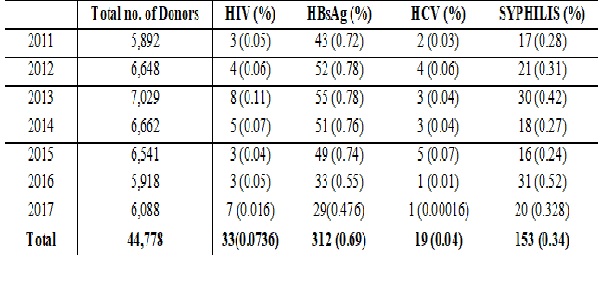Trends of transfusion transmittable infections among voluntary blood donors in a cardiac care hospital, Bengaluru, India
Abstract
Introduction: Transmission of infectious diseases through donated blood is of concern to blood safety as transfusion forms an integral part of medical and surgical therapy. Blood transfusion carries the risk of transfusion-transmittable infections including HIV, hepatitis–B etc. Screening of voluntary donors who represent healthy population serves as a predictor for these dreadful diseases in healthy population.
Materials and Methods: This retrospective study was conducted at the blood bank of Sri Jayadeva Institute of Cardiovascular Sciences and Research, Bengaluru. Data were analyzed for a period of 7 years from January 2011 to December 2017. All voluntary donors including replacement donors of our blood bank were screened for Hepatitis B Virus (HBV), Hepatitis C Virus (HCV) and Human Immunodeficiency Virus (HIV) and Syphilis infection by using ELISA.
Results: The most common infection was Hepatitis B (0.69%) followed by Syphilis (0.34%) and HIV (0.0736%) and least with HCV (0.04%) in our study.
Conclusion: This study has shown a decrease in seroprevalence for HIV and increase in seroprevalence for HCV over 7 years study period.
Downloads
References
Lavanchy D. Hepatitis B virus epidemiology, disease burden, treatment, and current and emerging prevention and control measures. J Viral Hepat. 2004 Mar;11(2): 97-107.
Narahari S, Juwle A, Basak S, et al. Prevalence and geographic distribution of Hepatitis C Virus genotypes in Indian patient cohort. Infect Genet Evol. 2009 Jul;9 (4):643-5.doi: https://doi.org/10.1016/j.meegid.2009.04.001. Epub 2009 Apr 11.
Widmann FK, editor. Technical manual American association of blood banks. Aglington USA: 1985. p. 325-44.
Hollan SR, Wagstaff W, Leikola J, Lothe F. Management of blood transfusion services, Geneva: World Health Organization; 1990. p.131.
National AIDS Control Organization. Standards for Blood Banks and Blood Transfusion Services. New Delhi: Ministry of Health and Family Welfare Government of India; 2007.
Screening donated blood for transfusion. World Health Organization 2010.
Mathai J, Sulochana PV, Satyabhama S, et al. Profile of transfusion transmissible infections and associated risk factors among blood donors of Kerala. Indian J Pathol Microbiol. 2002 Jul;45(3):319-22.
Srikrishna A, Sitalakshmi S, Damodar P. How safe are our safe donors? Indian J Pathol Microbiol. 1999 Oct;42(4):411-6.
Nanu A, Sharma SP, Chatterjee K, et al. Markers for transfusion-transmissible infections in north Indian voluntary and replacement blood donors: prevalence and trends 1989-1996. Vox Sang. 1997;73(2):70-3.
Sawke N, Sawke GK, Chawla S. Seroprevalence of Common Transfusion - Transmitted infections among Blood Donors. People's Journal of Scientific Research. 2010; 3 (1): 5-8.
Gupta N, Kumar V, Kaur A. Seroprevalence of HIV, HBV, HCV and syphilis in voluntary blood donors. Indian J Med Sci. 2004 Jun;58(6):255-7.
Meena M, Jindal T, Hazarika A. Prevalence of hepatitis B virus and hepatitis C virus among blood donors at a tertiary care hospital in India: a five-year study.Transfusion. 2011Jan;51(1):198-202.doi: https://doi.org/10.1111/j.1537-2995.2010.02801.x.
Tiwari B, Ghimire P, Karkee S, Rajkarnikar M. Seroprevalence of human immunodeficiency Virus in Nepalese blood donors: A study from three regional blood transfusion services. Asian J Transf Sci 2008; 2: 66-8.
Sonwane BR, Birare SD, Kulkarni PV. Prevalence of seroreactivity among blood donors in rural population. Indian J Med Sci. 2003 Sep;57(9):405-7.
Chandra T, Kumar A, Gupta A. Prevalence of transfusion transmitted infections in blood donors: an Indian experience. Trop Doct. 2009 Jul; 39 (3):152-4. doi: https://doi.org/10.1258%2Ftd.2008.080330.
Chandra T, Rizvi SN, Agarwal D. Decreasing prevalence of transfusion transmitted infection in Indian scenario. Scientific World Journal. 2014;2014:173939. Published 2014 Jan 27. doi: https://doi.org/10.1155/2014/173939.



 OAI - Open Archives Initiative
OAI - Open Archives Initiative


